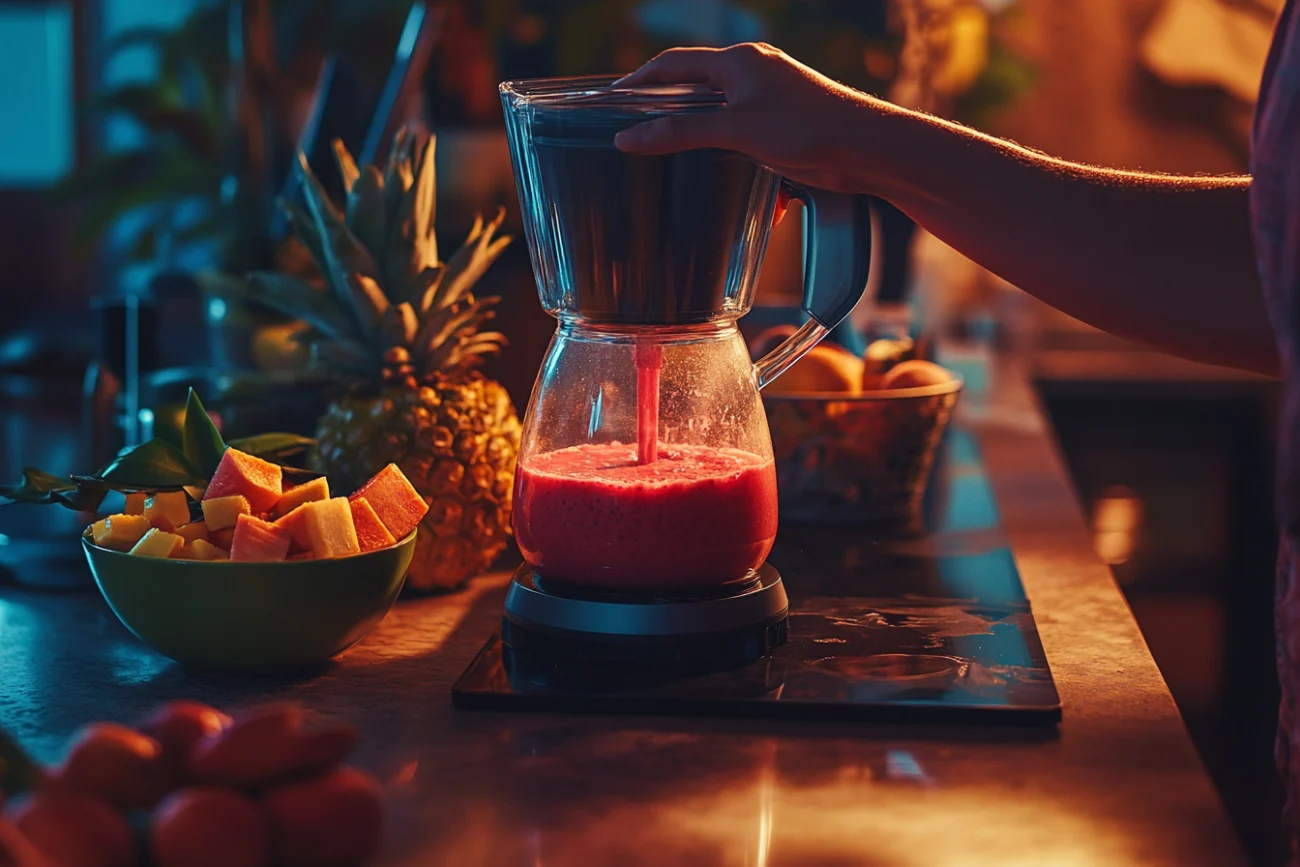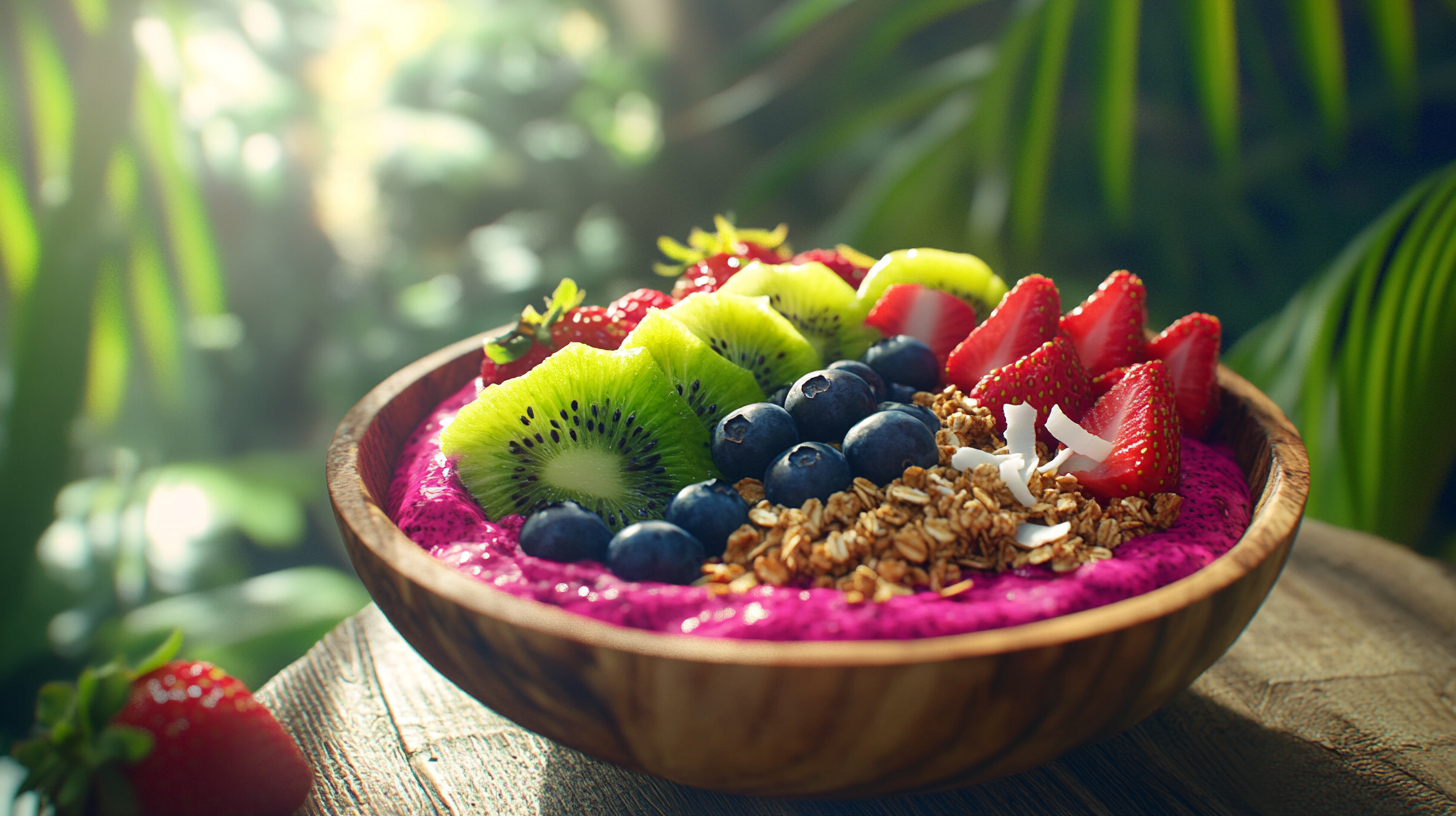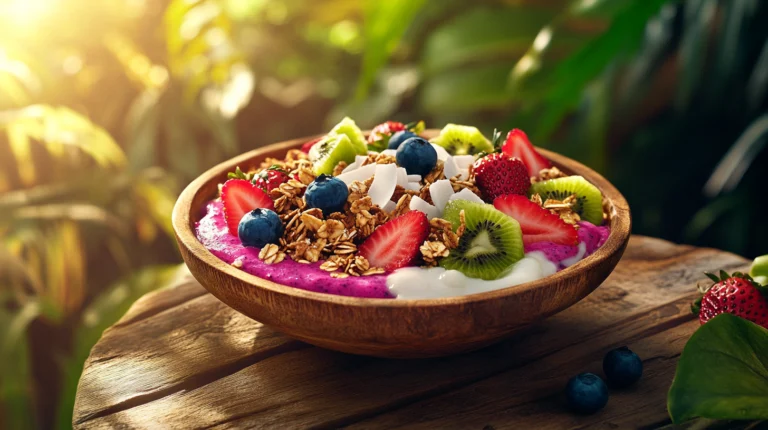Introduction: The Rise of the Pitaya Bowl
Ever scroll through Instagram and see those vibrant, pink smoothie bowls that look almost too pretty to eat? That’s the pitaya bowl—aka dragon fruit bowl—a refreshing, nutrient-packed way to start your day. It’s not just a breakfast; it’s a whole vibe. People love it for its tropical flavor, stunning color, and health benefits.
Whether you’re looking to upgrade your breakfast game, impress your friends, or fuel a busy day, this guide will show you how to make the perfect pitaya bowl. Trust me, once you whip up one of these beauties, your mornings will never be the same.
What is Pitaya?
Let’s break it down: pitaya, better known as dragon fruit, is a tropical fruit that comes from a cactus. Learn more about Pitaya Bowls on Wikipedia.
There are two main types of pitaya:
- Red-fleshed: Bright magenta inside with tiny black seeds. It’s the one that gives pitaya bowls their Insta-famous color.
- White-fleshed: Less vibrant but equally delicious and slightly sweeter.
When it comes to nutrition, pitaya is a superstar. It’s low in calories but loaded with vitamin C, antioxidants, and fiber. The seeds even pack a punch with healthy omega-3 and omega-6 fatty acids.
For additional ideas on starting your mornings with vibrant meals, check out Sweet Breakfast Recipes. healthy omega-3 and omega-6 fatty acids. So, not only does it taste great, but it’s good for you too.
Table of contents
Anatomy of a Pitaya Bowl
At its core, a pitaya bowl is like a smoothie, but thicker—think soft-serve consistency. It’s made by blending frozen pitaya with other fruits, and the fun part comes in layering it with toppings that add texture and crunch.
Here’s what goes into a basic pitaya bowl:
- The Base: Frozen pitaya (or pitaya puree), often mixed with banana or mango to make it creamy.
- The Toppings:
- Fresh fruits like kiwi, strawberries, and blueberries.
- Crunchy add-ons like granola, chia seeds, or coconut flakes.
- Nut butters or honey for an extra drizzle of flavor.
- The Consistency: Thick enough to hold up your toppings but smooth enough to eat with a spoon.
Pro tip: Use frozen fruit for the base to achieve that perfect creamy texture without watering it down. For more tips on creating perfect bowls, explore Create the Perfect Breakfast Bowl.
Health Benefits of Pitaya Bowls
Sure, they look great, but are they actually good for you? Oh, 100%. Pitaya bowls are more than just pretty—they’re packed with nutrients that can boost your overall health.
Here are some key benefits:
- Antioxidants: The bright pink color comes from betalains, which are powerful antioxidants that can fight inflammation and promote heart health.
- Fiber: Great for digestion and keeping you full longer, making it a smart breakfast or snack choice.
- Vitamin C: Helps support your immune system and gives you glowing skin.
- Low Calories, Big Flavor: A win for anyone watching their calorie intake without sacrificing taste.
Whether you’re chasing a health goal or just want a delicious treat, pitaya bowls check all the boxes. Discover Breakfast Recipes with a Twist.
Making and Customizing Pitaya Bowls
How to Make a Pitaya Bowl
Making a pitaya bowl at home is ridiculously easy, and it’ll save you the $10+ price tag at most cafes. Plus, you can tweak it to your taste. Here’s the step-by-step process to whip up a vibrant, creamy pitaya bowl right in your kitchen.

Ingredients You’ll Need:
- 1 cup frozen pitaya (look for pitaya packets or cubes in the freezer aisle)
- 1 banana (frozen works best for creaminess)
- ½ cup of liquid (options: almond milk, coconut water, or regular milk)
- Optional: a handful of frozen mango or pineapple for extra sweetness
Step-by-Step Instructions:
- Blend the Base: Toss the frozen pitaya, banana, and liquid into a high-speed blender. Start on low speed and gradually increase to high. If the blender struggles, add a splash more liquid—but don’t overdo it, or the consistency will be too thin.
- Achieve That Perfect Consistency: Stop blending once it looks like soft-serve ice cream. You want it thick enough to support all your toppings without sinking.
- Pour and Decorate: Scoop your blend into a bowl and smooth it out with a spoon. Now, the fun part: pile on the toppings!
- Serve and Enjoy: Grab a spoon, snap a quick photo (because, why not?), and dig in.
Pro Tips for the Perfect Pitaya Bowl:
- Use a tamper (if your blender has one) to keep things moving without adding extra liquid.
- For a sweeter bowl, toss in a date or a drizzle of honey.

Customizing Your Pitaya Bowl
The beauty of pitaya bowls is how customizable they are. You can swap ingredients based on your mood, diet, or what’s lurking in your fridge. Here are a few ideas to keep things fresh:
Fruit Pairings:
- Go tropical with pineapple, mango, and coconut.
- Add berries like strawberries, blueberries, or raspberries for a tangy twist.
- Feeling adventurous? Try passion fruit or kiwi for a zesty kick.
Protein Boosters:
- Toss in a scoop of protein powder (vanilla works well).
- Add Greek yogurt for creaminess and a protein punch.
- Sprinkle hemp seeds or chia seeds on top for extra protein and omega-3s.
Sweeteners:
- Keep it natural with a drizzle of honey, maple syrup, or agave.
- Want less sugar? Leave it out—the fruit is sweet enough on its own!
Liquid Bases:
- Almond milk keeps it light and nutty.
- Coconut water adds a tropical vibe.
- Oat milk gives a slightly creamy texture.
Toppings and Garnishe
Let’s be real—the toppings are half the fun. They’re where you get to show off your creativity (and make your bowl look Instagram-worthy). Here’s a go-to list to inspire you:
Fresh Fruits:
- Sliced banana, kiwi, or strawberries
- Blueberries or blackberries
- A few cubes of fresh dragon fruit for double the pitaya power
Crunchy Add-Ons:
- Granola or cereal
- Chopped almonds, walnuts, or cashews
- Toasted coconut flakes
Special Touches:
- A drizzle of peanut butter, almond butter, or tahini
- A sprinkle of chia seeds or flaxseeds
- Edible flowers like pansies or violets for that “wow” factor
Variations of Pitaya Bowls
Pitaya bowls are super versatile, so you can play around with flavors to match your cravings or dietary needs. Here are some fun variations to try:
- Tropical Pitaya Bowl: Blend frozen pitaya with mango and coconut water, then top with pineapple and toasted coconut.
- Green Pitaya Bowl: Add a handful of spinach or kale for extra nutrients—don’t worry, the pitaya’s flavor hides the greens!
- Protein-Packed Pitaya Bowl: Mix in protein powder and top with peanut butter and chia seeds for a post-workout snack.
Nutritional Information and Comparisons
Nutritional Breakdown of a Standard Pitaya Bowl
Pitaya bowls aren’t just pretty—they’re a powerhouse of nutrients that make them a smart choice for breakfast, a snack, or even dessert. Here’s what you’re getting in a typical pitaya bowl:
Calories:
A standard bowl ranges from 200–300 calories, depending on the toppings and additional ingredients. It’s satisfying without being heavy, making it ideal for lighter meals.
Macronutrients:
- Carbohydrates: Most of the calories come from natural fruit sugars and fiber, giving you a quick energy boost while keeping you full longer.
- Protein: While pitaya itself is low in protein, adding Greek yogurt, protein powder, or seeds can easily boost the content.
- Fat: Minimal unless you add toppings like nuts, seeds, or nut butter—which, let’s be honest, you totally should!
Micronutrients:
- Vitamin C: Pitaya is loaded with this immune-boosting vitamin.
- Magnesium: Great for muscle health and relaxation.
- Iron: Helps improve energy and oxygen circulation.
Fiber Content:
Each bowl packs around 5–7 grams of fiber, thanks to the pitaya, banana, and any added toppings like chia seeds. That’s nearly a quarter of your daily recommended intake!
Pitaya Bowl vs. Other Smoothie Bowls
If you’re wondering how pitaya bowls stack up against other smoothie bowls, here’s a quick comparison:
Acai Bowl vs. Pitaya Bowl:
- Color and Flavor: Pitaya is vibrant pink with a mildly sweet, tropical taste. Acai is dark purple and has an earthy, tart flavor.
- Calories: Pitaya is slightly lower in calories because it has less natural sugar compared to acai.
- Nutrients: Acai boasts more antioxidants, but pitaya wins with its higher fiber and vitamin C content.
Pitaya Bowl vs. Other Fruit-Based Bowls:
- Mango or Berry Bowls: These are delicious but don’t quite match pitaya’s unique flavor and fiber profile. Plus, pitaya’s color is in a league of its own!
- Green Smoothie Bowls: Packed with leafy greens, they’re great for nutrients but lack the fun, fruity flavor of a pitaya bowl.
Pitaya Bowls for Special Diets
One of the best things about pitaya bowls is how easy they are to adapt for different dietary needs. Here’s how to customize them:

Vegan-Friendly Options:
- Use plant-based milk like almond, oat, or coconut.
- Top with granola, fruits, and seeds—no honey or yogurt needed.
Gluten-Free Choices:
- Double-check your granola (not all are gluten-free).
- Stick with naturally gluten-free toppings like nuts, seeds, and fresh fruits.
Low-Sugar Variations:
- Use unsweetened liquids like coconut water or almond milk.
- Skip added sweeteners and rely on the natural sweetness of pitaya and banana.
Keto-Friendly Adaptations:
- Swap high-sugar fruits like banana for avocado or unsweetened coconut cream in the base.
- Add toppings like unsweetened coconut flakes, nuts, and a dollop of almond butter.
Pitaya bowls are as versatile as they are nutritious, making them an easy win for just about any lifestyle. Let’s move on to Part 4 to see how pitaya bowls are influencing culture and even businesses. Ready? Let’s go!
Pitaya Bowls in Culture and Business
Pitaya Bowls in Popular Culture
If you’ve ever opened Instagram, you’ve probably seen a pitaya bowl staring back at you—vivid pink, perfectly topped, and ready for its close-up. These bowls are practically made for social media. Their vibrant colors and customizable designs have made them a favorite among influencers, food bloggers, and health enthusiasts.
Pitaya bowls also align perfectly with the growing trend of “eating pretty.” People aren’t just looking for delicious meals—they want something beautiful and nutrient-rich. From #PinkSmoothieBowl hashtags to TikTok tutorials, pitaya bowls have earned their spot as a photogenic breakfast staple.
Celebrity endorsements have also played a role in their popularity. Stars like Gwyneth Paltrow and Jessica Alba have raved about smoothie bowls (including pitaya), giving them a boost in the wellness scene.
The Business of Pitaya Bowls
Pitaya bowls are no longer just a DIY kitchen project—they’re a booming business. Cafes, juice bars, and food trucks have embraced these colorful bowls, offering them as a staple menu item. Here’s why they’ve become such a hit:
Popularity in Cafes and Juice Bars:
- The vibrant color attracts customers looking for something fresh and trendy.
- They appeal to health-conscious eaters and smoothie lovers alike.
Franchising Opportunities:
- Smoothie and acai bowl chains are expanding their menus to include pitaya bowls.
- Entrepreneurs have jumped on the pitaya bandwagon, opening small businesses centered around these bowls.
Marketing Strategies:
- Highlighting the health benefits and beauty of pitaya bowls makes them easy to market.
- Social media campaigns often emphasize their photogenic quality, driving foot traffic and online orders.
Sustainability and Sourcing
Behind the beauty of pitaya bowls is a story about sourcing and sustainability. The pitaya fruit is mostly grown in tropical regions, including Central America, Southeast Asia, and Mexico. Here’s what you should know about its impact:
Ethical Sourcing:
- Look for suppliers that practice fair trade, ensuring farmers are paid fairly for their crops.
- Supporting local farmers in these regions helps promote sustainable farming practices.
Environmental Impact:
- Dragon fruit is relatively low-impact compared to some other tropical fruits.
- Buying frozen pitaya reduces food waste and keeps the product fresh longer.
Local vs. Imported:
- Imported pitaya is widely available in the U.S., but buying locally sourced versions (when possible) reduces the carbon footprint.
Pro Tip: If you’re making pitaya bowls at home, consider using organic options for both the fruit and toppings to align with an eco-friendly approach.
FAQs: Your Pitaya Bowl Questions Answered
Here are some common questions people ask about pitaya bowls:
- Are pitaya bowls healthy?
Absolutely! They’re packed with antioxidants, vitamins, and fiber. Just watch your toppings if you’re counting calories. - Can I make a pitaya bowl without a blender?
It’s tricky, but you can try mashing the fruit with a fork and mixing it with yogurt for a similar effect. - How many calories are in a typical pitaya bowl?
On average, about 200–300 calories, depending on the ingredients and toppings. - Is pitaya the same as dragon fruit?
Yes! Pitaya is another name for dragon fruit. - Can pitaya bowls help with weight loss?
They can be part of a weight-loss plan, thanks to their low-calorie, high-fiber nature. Just avoid heavy, sugary toppings. - Where can I buy pitaya for bowls?
Check the frozen section of your grocery store for pitaya packets or cubes. Many stores also sell fresh dragon fruit.
Pitaya bowls have gone from trendy breakfast to cultural phenomenon, making waves in food, health, and business. Whether you’re enjoying one at home or ordering from your local juice bar, it’s clear this pink powerhouse is here to stay.
Now that you know all about pitaya bowls, why not try making one yourself? It’s your chance to create something healthy, delicious, and—let’s face it—totally Instagram-worthy!

